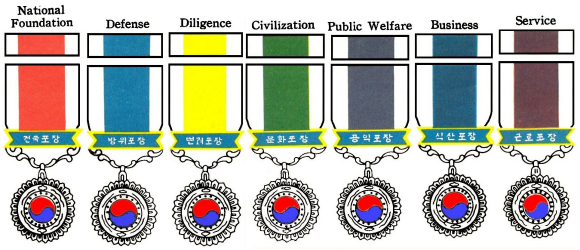

The ribbon colors for defense and Business are almost identical. There are also significant differences in the enameling, but this is primarily due to different manufacturers and different production batches. Moreover, manufacturers were working from the legal code that, for instance, specified green enamel, but did not specify the shade or amount of green enamel.
The original series of Merit Medals was established on Jun. 6, 1949 under Presidential Decree #128. The planchets were identical for all seven Merit Medals. They are differentiated from one and other, by the Korean script on the metal clasp at the base of the ribbon and by the ribbon colors. The Taeguk symbol in the design indicates the Korean National Flag; the chain, preservation of national traditions; the arrowroot, the fruit of diligence; the leaves of Mugunghwa, national prosperity; and the green circle design, high purpose. This series remained unchanged until January 1967. Variations in the quality of workmanship are known to exist. The thickness of the planchets varies considerably.
The following listing is done by the precedence as established on Jun. 6, 1949. After the military gained political power in 1961, the Defense Merit Medal took precedence over the Diligence Merit Medal under Decorations Law #1519.
- National Foundation Merit Medal 건국포장 (建國褒章): Awarded to those who distinguish themselves with meritorious service to the independence movement (독립운동 – 獨立運動) and to the foundation of the Republic of Korea. The red color of the ribbon symbolizes patriotism.
- Diligence Merit Medal 면려포장 (勉勵褒章): Awarded to those who distinguish themselves as government employees in the performance of their duties. Military personnel and civilians in military organizations were not eligible for this medal. The yellow color of the ribbon indicates co-operative spirit.
- Defense Merit Medal 방위포장 (防衛褒章): Awarded to those who render meritorious services to the defense and security of the nation, or to those who save the lives and properties of others at the risk of their own. The blue color of the ribbon indicates justice. This medal is sometimes erroneously referred to as the “Defense of Seoul Medal”.
- Cultural Merit Medal 문화포장 (文化褒章): Awarded to those who render meritorious services in the fields of education, science, arts and cultural development. It is also known as the Civilization Merit Medal. The green color of the ribbon indicates future progress.
- Public Welfare Merit Medal 공익포장 (公益褒章): Awarded to those who distinguish themselves in the field of national welfare by donating private properties, or managing the work of public welfare or public utilities. The navy-blue color of the ribbon indicates sincerity.
- Business/Industrial service Merit Medal 식산포장 (殖産褒章 or 植産褒章): Awarded to those who render distinguished service in the development or advancement of industry, or to those who are exemplary in their business. It is also known as the Business Merit Medal. The indigo color of the ribbon indicates creativity.
- Service/Labor Merit Medal 근로포장 (勤勞褒章): Awarded to those who distinguish themselves with patriotic service as workers in factories, workshops, etc. It is also known as the Service Merit Medal. The purple color of the ribbon indicates perseverance.
Only a Commendation Document 표창 (表彰) is given in the case where the awardee, is a group or an organization. A Gold and Silver Cup 금은배 (金銀杯), or money 금원 (金圓) could also be awarded to the person who was conferred a medal.1
Ribbon attachment for multiple awards (식관)

A repeated award of a Merit Medal is indicated by the addition of a metal attachment (식관) to the ribbon. It is unclear if the attachment was used after 1963. Likewise, It is unclear if a second attachment was used for a third award. To date, I have not been able to find a reasonable picture of this attachment. I have seen award groups which had two identical Merit Medals.
Prototypes?

The reverse has the inscription 대한민국 “Republic of Korea”.
Pictured above is a drawing of the 1949 series of Merit Medals. The drawing clearly indicates that all the planchets are identical. The only differences between one medal and another are the ribbon colors and the Korean characters on the obverse bar above the suspension. Pictured on the right and left are two Merit Medals. According to the Korean legislation, these Merit Medals should not exist in this form. I would like to find more examples of this deviation to examine. It is likely that these are prototypes that were not approved for issuance. The existence of these two medals would imply that there should be one prototype for each of the seven medals.

The difference in ribbon color is due to fading.
The reverse has the inscription 대한민국 “Republic of Korea”.
